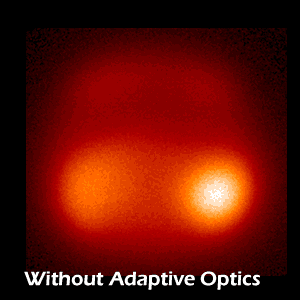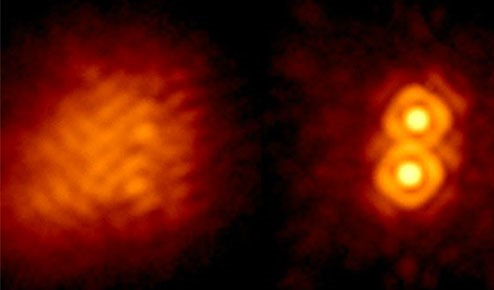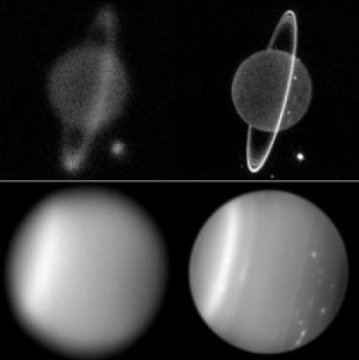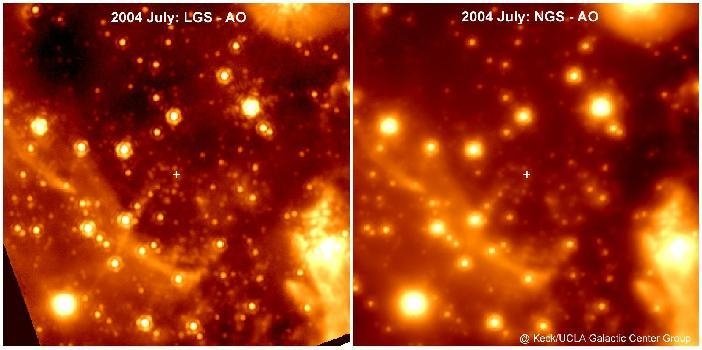Featuring the Work of Nobel Laureate Andrea Ghez

— Sky and Telescope Magazine (UCLA Galactic Center Group / W. M. Keck Observatory Laser Team)

Neptune, with and without adaptive optics.
— Sky and Telescope Magazine (University of California, Santa Cruz / UCLA Galactic Center Group)

An early AO system at Palomar Observatory shows the amorphous image on the left to actually be that of a binary star system.
— Sky and Telescope Magazine (Palomar Observatory / NASA-JPL)

Adaptive optics dramatically sharpens features in Uranus's atmosphere, such as storms and banding.
— Sky and Telescope Magazine (Heidi B. Hammel and Imke de Pater)

Though adaptive optics can be done with natural guide stars (i.e., by utilizing a nearby bright star in the sky), it's not always feasible, especially over a wide field of view. When bright stars are not available, observatories implement laser guide stars, a bright artificial star created by shining a laser beam into the sky. The image below shows the improvement from a natural guide star image of the galactic center (right) with a laser guide star image of the same field (left).
— Sky and Telescope Magazine (UCLA Galactic Center Group - W.M. Keck Observatory Laser Team)
A quarter century of determined effort has proven that there is a 4.2 million solar mass black hole at the heart of our galaxy, further confirming Einstein’s theory (and further disproving his intuition). “For the discovery of a supermassive compact object at the center of our galaxy” Ghez was awarded the Nobel Prize, half of which she shares with Reinhard Genzel of UC Berkeley and the Max Planck Institute for Extraterrestrial Physics. (The other half of the prize was awarded to Roger Penrose of the University of Oxford “for the discovery that black hole formation is a robust prediction of the general theory of relativity.”)
The animation below, from the UCLA Galactic Center Group, led by Ghez, shows the fruits of 25 years of observation, innovation and calculation. Click the play button to see the motions of stars as they orbit the supermassive black hole in the center; timestamp is shown in the upper right.
As Ghez has indicated in interviews and talks since the announcement of the Nobel Prize, the accolades are wonderful, but it's the work that matters the most. And the work of the Galactic Center Group goes on; the video below shows the kind of resolution future systems will provide.
Animation showing the improvement in resolution in the central 0.5” of the Galaxy from seeing-limited to Keck + Adaptive Optics to future Extremely Large Telescopes + Adaptive Optics. Actual orbits are shown in the seeing-limited and Keck cases, while additional simulated orbits are included for the ELT case. See a side-by-side comparison in this 3-panel.
— UCLA Galactic Center Group
For more on Dr. Andrea Ghez and the work that earned her the Nobel prize, please see this UCLA Newsroom article or the UCLA Galactic Center Group’s website, which features more images and animations.
Access Ghez’s Nobel lecture here.
Visit the "Then and Now" archive.